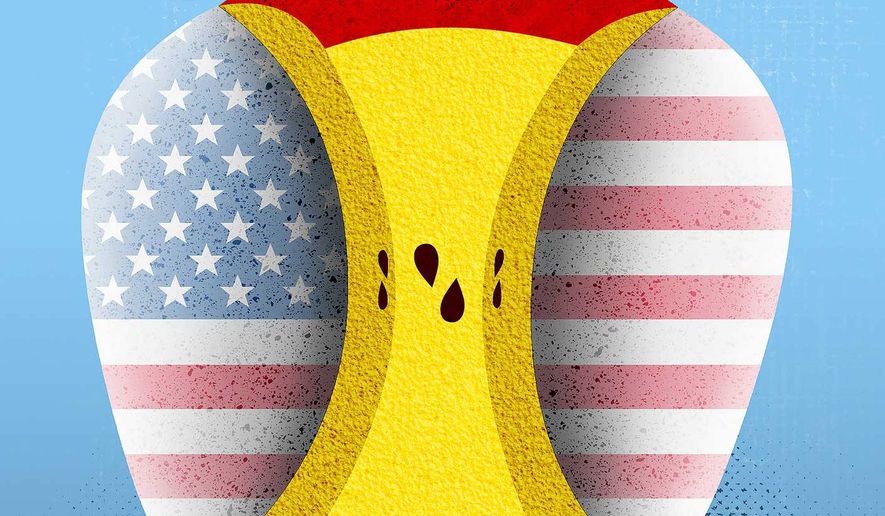OPINION:
New York Gov. Kathy Hochul’s recent announcement for overhauling the K-12 education system in New York rightly recognizes the teacher shortage, which has become a crisis. But it does not change the underlying incentives for attracting talented people into teaching or retaining the teachers who do a good job educating their students.
From urban to suburban to rural, schools are desperate for personnel to staff classrooms. Classrooms are often forced to combine to ensure an adult is present to supervise students. And administrators are regularly substituting as teachers, lunchroom monitors and cafeteria workers. These shortages wear existing school personnel out and reduce the student experience.
When the human supply runs too short, schools are canceling for multiple days or even weeks at a time, often with little notice — forcing a significant hardship on working parents and causing students to fall further behind in their learning. These teacher shortfalls are especially detrimental to the development of children in light of what they’ve already been experiencing since 2020 due to COVID-19 responses.
The K-12 public education system started the 2021-2022 school year with 1.5 million fewer students than the previous year, and many more have withdrawn mid-year. Even with the resulting reduced demand for teachers, the supply has not kept pace. Data from Emsi Burning Glass, revealing that job postings for teachers have grown by 79% over the past year, illustrates the magnitude of the teacher shortage.
The challenges are not new. Rather, the past two years have accelerated what has long been a structural challenge within the K-12 education system for years — its inability to attract sufficient numbers of quality teachers.
For starters, the current system holds teacher certification as a sacred cow and fails to recognize subject matter expertise gained through advanced degrees, professional experience or a combination of the two. Instead, a teaching certificate from hundreds of programs around the country serves as the gatekeeper. Little concern is given to the vastly differing quality or admissions requirements of the teacher preparation programs.
Certification requirements stifle the supply of teachers by raising unnecessary barriers to entry and unnecessarily hinder the geographical movement of teachers. Since certifications vary state-to-state, many teachers feel constrained to stay put, even if they could find a better opportunity or quality of life in another state. Researchers have found that voluntary certification would provide at least as many benefits without the costs.
While Mrs. Hochul’s announcement recognizes the long wait times in the certification process and endeavors to address it by hiring additional staff to facilitate teacher certification, the problem is that the entire certification process is broken. What we need is not more staff but a different process for attracting, vetting and retaining talent.
Unfortunately, both the recruiting and the retaining of excellent teachers are hindered by a system that rewards tenure instead of performance.
The longstanding recognition in labor economics is that the alternative to longevity pay — pay for performance — creates stronger performance incentives for current workers. It also attracts higher-caliber candidates because talented workers want a system that recognizes and rewards their performance. The result of performance pay is systematic improvements in teacher quality and productivity.
Simply raising salaries uniformly, as Mrs. Hochul has recommended, risks discouraging effort even more than it already is in the system. In fact, the main problem in U.S. teacher pay is not low pay uniformly, but rather the lack of customization and failure to link pay with performance. A further issue is the 9-month work year. Though it may be attractive for some (e.g., working moms with younger children), it shortchanges those desiring compensation for a 12-month professional employment career.
Another major problem negatively impacting the teacher workforce is the system’s overbearing bureaucracy, which dampens creativity and innovation, and snuffs out creative problem-solving. All too often, the hands of teachers (and administrators) are tied by endless top-down, one-size-fits-all policies and procedures, preventing them from providing personalized learning plans for each student. Mrs. Hochul’s recommendation to bring additional billions into the education system sounds good in theory but does little to create incentives for performance. Customization is increasingly needed, especially given the varying learning styles of children and the necessity to prepare students for the increasingly complex workforce.
Teachers unions add to the bloated bureaucracy. Despite the extreme measures of teachers unions to promote employee working conditions and compensation, research reveals that right-to-work laws positively affect workers, including their well-being.
Job performance and job satisfaction are often higher among nonunionized teachers, such as those working in charter and private schools. For example, data consistently confirms that charter and private school students outperform traditional public school students. With the teacher the number one factor beyond parents influencing student learning, the powerful impact of the human capital in the classroom is revealed. And these charter and private school teachers willingly work for less pay with a mere fraction of the benefits traditional public school teachers receive, signaling strong job satisfaction.
Continuing down the current path, which is failing our students and shuttering our schools, is unacceptable. We need to stop throwing good money after bad and rethink K-12 education from a systems perspective. Of fundamental importance is getting incentives right. With the teacher shortage crisis at hand, there is a timely opportunity to adjust the system. We must attract the right teachers and reward them based on the quality of work to deliver premium educational services to students.
The best way to do that is by linking pay with performance. While critics of pay for performance often argue that it harms students, empirical analysis has provided enormous evidence to the contrary. Even though performance pay has not been implemented on a large scale (primarily due to teachers unions’ politicization of the issue), there are examples of positive results. One example is the Dallas Independent School District, where the approach has led to substantial student learning gains.
Finally, we need to muster the political courage to challenge the unbridled power of the teachers unions. Their resistance to performance-based pay for teachers and preventing even the lowest-performing teachers from getting fired keeps the U.S. K-12 education system in a state of mediocrity.
The system must be redesigned to address these flawed approaches and practices growing the acquisition and compensation of educators. That means ending the teacher shortage and creating a system that allows and incentives our top subject matter experts and those with the ability to demonstrate remarkable teaching skills the opportunity to not only enter but have the necessary flexibility to transform our K-12 classrooms.
• Keri D. Ingraham is a fellow at Discovery Institute and director of the Institute’s American Center for Transforming Education. Christos A. Makridis is a research affiliate at Stanford University and Columbia Business School.




Please read our comment policy before commenting.